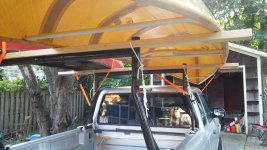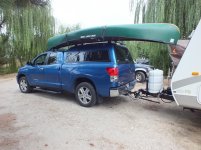I'm on my 4th pickup truck and have long avoided caps. It seemed to me it turned it into a station wagon with even worse access to the cargo. Forget getting a yard of compost dumped into the bed of the truck.
However, the last truck I bought I decided to put a cap on it for several reasons. Since my first truck, caps have come a long way. The clincher for me was winged side windows that allow me to reach anything in the bed. It cost a little extra to have the side windows winged with screen, but is worth it for the bed access it gives you. Another option I selected was to have LED strip lighting above the windows that can be enabled to turn on when you open the side windows.

Getting a Yakima rail and bar setup on the cap was a very inexpensive option with the cap setup. ARE (the cap manufacturer) seemed to price the Yakima cap option at their cost; I couldn't find anything remotely close to the price they asked for. I added a Yakima clamp on bar on the truck cab, starting with the rear seat postion. Despite concerns I've heard about cab and bed twisting that can occur I've never had a problem. Off road use may create this problem, but I do little of this and my setup handles high speed highway travel for extended periods without any issues.
I did find that I needed to put a bar over the front doors to lift the bow of my 15 foot whitewater boat off the truck cab roof. The curve the rocker imparts to the canoe required a bar there to keep it off the truck cab roof. My other canoes fit fine with gunnels on the cap and truck cab rear door position.

With my first cap, I did "pimp" it out so I could sleep in it. One side benefit of that effort was in building a bench for the bed it created a perfect place to store paddles, keeping them away from any harm that might happen to them in tossing heavy gear around in the back.

However, the last truck I bought I decided to put a cap on it for several reasons. Since my first truck, caps have come a long way. The clincher for me was winged side windows that allow me to reach anything in the bed. It cost a little extra to have the side windows winged with screen, but is worth it for the bed access it gives you. Another option I selected was to have LED strip lighting above the windows that can be enabled to turn on when you open the side windows.

Getting a Yakima rail and bar setup on the cap was a very inexpensive option with the cap setup. ARE (the cap manufacturer) seemed to price the Yakima cap option at their cost; I couldn't find anything remotely close to the price they asked for. I added a Yakima clamp on bar on the truck cab, starting with the rear seat postion. Despite concerns I've heard about cab and bed twisting that can occur I've never had a problem. Off road use may create this problem, but I do little of this and my setup handles high speed highway travel for extended periods without any issues.
I did find that I needed to put a bar over the front doors to lift the bow of my 15 foot whitewater boat off the truck cab roof. The curve the rocker imparts to the canoe required a bar there to keep it off the truck cab roof. My other canoes fit fine with gunnels on the cap and truck cab rear door position.

With my first cap, I did "pimp" it out so I could sleep in it. One side benefit of that effort was in building a bench for the bed it created a perfect place to store paddles, keeping them away from any harm that might happen to them in tossing heavy gear around in the back.





